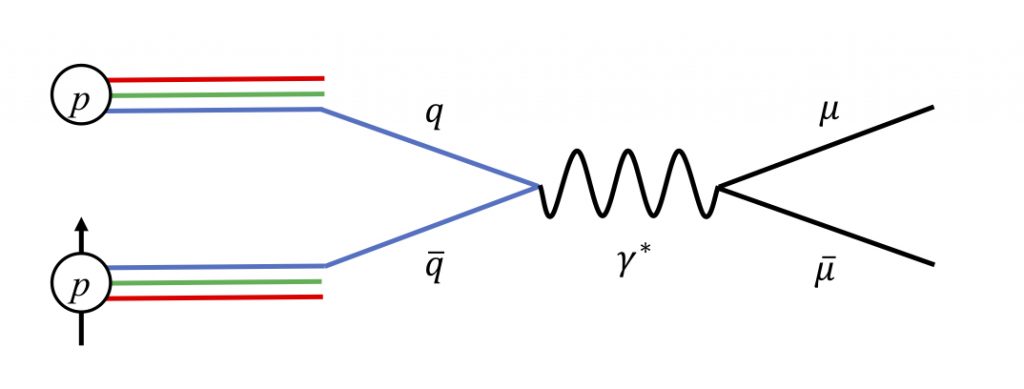SpinQuest/E1039 is a fixed-target Drell-Yan experiment using the Main Injector beam at Fermilab, in the NM4 hall. It follows up on the work of the NuSea/E866 and SeaQuest/E906 experiments at Fermilab that sought to measure the d/u ratio on the nucleon as a function of Bjorken-x. By using transversely polarized targets of NH3 and ND3, SpinQuest seeks to measure the Sivers asymmetry of the u and d quarks in the nucleon, a novel measurement aimed at discovering if the light sea quarks contribute to the intrinsic spin of the nucleon via orbital angular momentum.

While much progress has been made over the last several decades in determining the longitudinal structure of the nucleon, both spin-independent and -dependent, features related to the transverse motion of the partons, relative to the collision axis, are far less-well known. There has been increased interest, both theoretical and experimental, in studying such transverse features, described by a number of “Transverse Momentum Dependent parton distribution functions” (TMDs). Among those is the Sivers function [Sivers] which represents the correlation between the kT of a parton and the spin of its parent, transversely polarized, nucleon. Sivers suggested that an azimuthal asymmetry in the kT distribution of such partons could be the origin of the unexpected, large, transverse, single-spin asymmetries observed in hadron-scattering experiments since the 1970s [FNAL-E704].
Non-zero values of the Sivers asymmetry have been measured in semi-inclusive, deep-inelastic scattering experiments (SIDIS) [HERMES, COMPASS, JLAB]. The valence up- and down-quark Siverse functions were observed to be similar in size but with opposite sign. No results are available for the sea-quark Sivers functions.
The SpinQuest/E1039 experiment will measure the sea-quark Sivers function for the first time. By using both polarized proton (NH3) and deuteron (ND3) targets, it will be possible to probe this function separately for u and d antiquarks. A predecessor of this experiment, NuSea/E866 demonstrated conclusively that the unpolarized u and d distributions in the nucleon differ [FNAL-E866], explaining the violation of the Gottfried sum rule [NMC]. Therefore it is not unreasonable to assume that the Sivers functions may also differ. An added advantage of using the Drell-Yan process is that it is cleaner, compared to the SIDIS process, both theoretically, not relying on phenomenological fragmentation functions, and experimentally, due to the straightforward detection and identification of dimuon pairs. The Sivers function can be extracted by measuring a Sivers asymmetry, due to a term sinφS(1+cos2θ) in the cross section, where φS is the azimuthal angle of the (transverse) target spin and θ is the polar angle of the dimuon pair in the Collins-Soper frame. Measuring the sea-quark Sivers function will allow a test of the sign-change prediction of QCD when compared with future measurements in SIDIS at the EIC.
The experiment will use the SeaQuest spectrometer which consists of two magnets and four stations of scintillator hodoscopes and wire chambers: the first three drift chambers and the fourth, serving as a muon identifier, proportional tubes. It has kinematic coverage such that for relatively large values of x2, the target Bjorken-x, target sea quarks dominate the Drell-Yan process, as this region corresponds to large values of x1, where only valence quarks are present. SpinQuest/E1039 is planning to probe lower x2 values and therefore the target position has been moved further upstream of the beam dump to increase acceptance in the low-x2 range, as well as improve separation for target and dump events.There are other opportunities to study transverse-spin effects with the SpinQuest experiment; of particular is the transverse, single-spin asymmetry (TSSA) in J/ψ production. In spite of a restrictive trigger, SeaQuest/E906 recorded copious J/ψ events and SpinQuest/E1039 is expected to see much higher numbers. The J/ψ TSSA can be used to study the gluon Sivers functions.
In addition to studies of nucleon structure, an interesting idea is to use dimuons originating in the beam dump to search for exotic particles, such as dark photons and dark Higgs particles, which may decay to muon pairs. A Letter of Intent to collect data in parasitic mode, requiring only minor upgrades to the spectrometer and trigger, has been received well by the lab and the collaboration is considering the necessary enhancements to enable this search.
